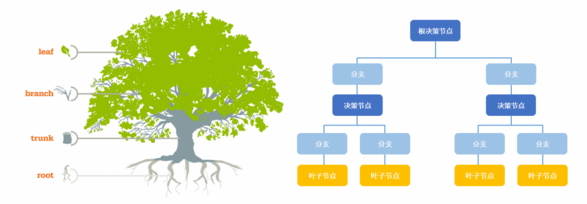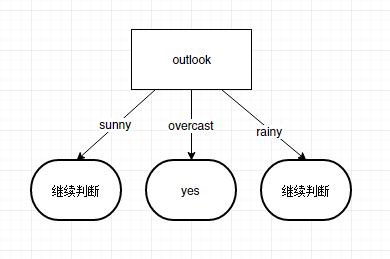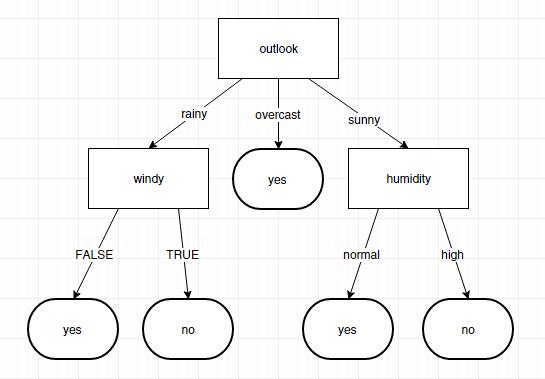转载请注明出处:
http://blog.csdn.net/gane_cheng/article/details/53897669
http://www.ganecheng.tech/blog/53897669.html (浏览效果更好)
决策树是一种树形结构,为人们提供决策依据,决策树可以用来回答yes和no问题,它通过树形结构将各种情况组合都表示出来,每个分支表示一次选择(选择yes还是no),直到所有选择都进行完毕,最终给出正确答案。
本文介绍决策树如何来实现分类,并用来预测结果。
先抛出问题。现在统计了14天的气象数据(指标包括outlook,temperature,humidity,windy),并已知这些天气是否打球(play)。如果给出新一天的气象指标数据:sunny,cool,high,TRUE,判断一下会不会去打球。
| outlook | temperature | humidity | windy | play |
|---|---|---|---|---|
| sunny | hot | high | FALSE | no |
| sunny | hot | high | TRUE | no |
| overcast | hot | high | FALSE | yes |
| rainy | mild | high | FALSE | yes |
| rainy | cool | normal | FALSE | yes |
| rainy | cool | normal | TRUE | no |
| overcast | cool | normal | TRUE | yes |
| sunny | mild | high | FALSE | no |
| sunny | cool | normal | FALSE | yes |
| rainy | mild | normal | FALSE | yes |
| sunny | mild | normal | TRUE | yes |
| overcast | mild | high | TRUE | yes |
| overcast | hot | normal | FALSE | yes |
| rainy | mild | high | TRUE | no |
现在,我们想让所有输入情况可以更快的得到答案。也就是要求平均查找时间更短。当一堆数据区分度越高的话,比较的次数就会更少一些,也就可以更快的得到答案。
下面介绍一些概念来描述这个问题。
概念简介
决策树
决策树是一种树形结构,其中每个内部节点表示一个属性上的测试,每个分支代表一个测试输出,每个叶节点代表一种类别。
决策树是一种十分常用的分类方法。他是一种监管学习,所谓监管学习就是给定一堆样本,每个样本都有一组属性和一个类别,这些类别是事先确定的,那么通过学习得到一个分类器,这个分类器能够对新出现的对象给出正确的分类。这样的机器学习就被称之为监督学习。
香农熵
香农熵(entropy),简称熵,由美国数学家、信息论的创始人香农提出。用来定量表示信息的聚合程度,是信息的期望值。
划分数据集的大原则是:将无序的数据变得更加有序。自然界各种物体已经在我们基础教育,高等教育中被学到。世界本来是充满各种杂乱信息的,但是被人类不停地认识到,认识的过程还是循序渐进的。原本杂乱的信息却被我们系统地组织起来了,这就要归功于分类了。
学语文时,我们学习白话文,文言文,诗歌,唐诗,宋词,散文,杂文,小说,等等。
学数学时,加减乘除,指数,对数,方程,几何,微积分,概率论,图论,线性,离散,等等。
学英语时,名词,动词,形容词,副词,口语,语法,时态,等等。
学历史时,中国史,世界史,原始社会,奴隶社会,封建社会,现代社会,等等。
分类分的越好,我们理解,掌握起来就会更轻松。并且一个新事物出现,我们可以基于已经学习到的经验预测到它大概是什么。
熵就是用来描述信息的这种确定与不确定状态的,信息越混乱,熵越大,信息分类越清晰,熵越小。
我们来看一个例子,马上要举行世界杯赛了。大家都很关心谁会是冠军。假如我错过了看世界杯,赛后我问一个知道比赛结果的观众“哪支球队是冠军”? 他不愿意直接告诉我, 而要让我猜,并且我每猜一次,他要收一元钱才肯告诉我是否猜对了,那么我需要付给他多少钱才能知道谁是冠军呢? 我可以把球队编上号,从 1 到 32, 然后提问: “冠军的球队在 1-16 号中吗?” 假如他告诉我猜对了, 我会接着问: “冠军在 1-8 号中吗?” 假如他告诉我猜错了, 我自然知道冠军队在 9-16 中。 这样最多只需要五次, 我就能知道哪支球队是冠军。所以,谁是世界杯冠军这条消息的信息量只值五块钱。(球队第一种分类方式)
我们实际上可能不需要猜五次就能猜出谁是冠军,因为象巴西、德国、意大利这样的球队得冠军的可能性比日本、美国、韩国等队大的多。因此,我们第一次猜测时不需要把 32 个球队等分成两个组,而可以把少数几个最可能的球队分成一组,把其它队分成另一组。然后我们猜冠军球队是否在那几只热门队中。我们重复这样的过程,根据夺冠概率对剩下的候选球队分组,直到找到冠军队。这样,我们也许三次或四次就猜出结果。因此,当每个球队夺冠的可能性(概率)不等时,“谁世界杯冠军”的信息量的信息量比五比特少。(球队第二种分类方式)
熵定义为信息的期望值。求得熵,需要先知道信息的定义。如果待分类的事务可能划分在多个分类之中,则信息定义为
其中,
xi
表示第
i
个分类,
假如有变量X,其可能的分类有n种,熵,可以通过下面的公式得到:
其中, n 表示分类的数量。
以上面球队为例,第一种分类的话,所得球队的熵为:
如果是按第二种方式分类的话,假如,每个队得冠军的概率是这样的。
| 球队 | 分类 | 获胜概率 |
|---|---|---|
| 中国 | 强队 | 18% |
| 巴西 | 强队 | 18% |
| 德国 | 强队 | 18% |
| 意大利炮 | 强队 | 18% |
| 剩下的28只球队每队获胜概率都为1% | 弱队 | 1% |
现在分成了两个队强队和弱队,需要分别计算两队的熵,然后再计算总的熵。
强队的熵为:
弱队的熵为:
所得球队的总的熵为:
可以看到,如果我们按照强弱队的方式来分类,然后再猜的话,平均只需要2.8次就可以猜出冠军球队。
信息增益
信息增益(information gain) 指的是划分数据集前后信息发生的变化。
在信息增益中,衡量标准是看特征能够为分类系统带来多少信息,带来的信息越多,该特征越重要。对一个特征而言,系统有它和没它时信息量将发生变化,而前后信息量的差值就是这个特征给系统带来的信息量。所谓信息量,就是熵。
特征T给聚类C或分类C带来的信息增益可以定义为
其中, IG(T) 表示特征 T 带来的信息增益, H(C) 表示未使用特征 T 时的熵, H(C|T) 表示使用特征 T 时的熵。并且 H(C) 一定会大于等于 H(C|T) 。
例如,上面的球队按第一种分类得到的熵为 5,第二种分类得到的熵为 2.8,则强弱队这个特征为 32 只球队带来的信息增益则为:5-2.8=2.2 。
信息增益最大的问题在于它只能考察特征对整个系统的贡献,而不能具体到某个类别上,这就使得它只适合用来做所谓“全局”的特征选择。
一个特征带来的信息增益越大,越适合用来做分类的特征。
构造决策树
ID3 算法
构造树的基本想法是随着树深度的增加,节点的熵迅速地降低。熵降低的速度越快越好(即信息增益越大越好),这样我们有望得到一棵高度最矮的决策树。
好,现在用此算法来分析天气的例子。
在没有使用任何特征情况下。根据历史数据,我们只知道新的一天打球的概率是9/14,不打的概率是5/14。此时的熵为:
如果按照每个特征分类的话。属性有4个:outlook,temperature,humidity,windy。我们首先要决定哪个属性作树的根节点。
对每项指标分别统计:在不同的取值下打球和不打球的次数。
| outlook | yes | no |
|---|---|---|
| sunny | 2 | 3 |
| overcast | 4 | 0 |
| rainy | 3 | 2 |
因此如果用特征outlook来分类的话,总的熵为
然后,求得特征outlook获得的信息增益。
用同样的方法,可以分别求出temperature,humidity,windy的信息增益。IG(temperature)=0.029,IG(humidity)=0.152,IG(windy)=0.048。
因为 IG(outlook)>IG(humidity)>IG(windy)>IG(temperature)。所以根节点应该选择outlook特征来进行分类。
接下来要继续判断取temperature、humidity还是windy?在已知outlook=sunny的情况,根据历史数据,分别计算IG(temperature)、IG(humidity)和IG(windy),选最大者为特征。
依此类推,构造决策树。当系统的信息熵降为0时,就没有必要再往下构造决策树了,此时叶子节点都是纯的–这是理想情况。最坏的情况下,决策树的高度为属性(决策变量)的个数,叶子节点不纯(这意味着我们要以一定的概率来作出决策,一般采用多数表决的方式确定此叶子节点)。
构造决策树的一般过程
- 手机数据:可以使用任何方法。
- 准备数据:树构造算法只适用于标称型数据,因此数值型数据必须离散化。
- 分析数据:可以使用任何方法,构造树完成之后,我们应该检查图形是否符合预期。
- 训练算法:构造树的数据结构。
- 测试算法:使用经验树计算错误率。
- 使用算法:此步骤可以适用于任何监督学习算法,而使用决策树可以更好地理解数据的内在含义。
Java实现
定义数据结构
根据决策树的形状,我将决策树的数据结构定义如下。lastFeatureValue表示经过某个特征值的筛选到达的节点,featureName表示答案或者信息增益最大的特征。childrenNodeList表示经过这个特征的若干个值分类后得到的几个节点。
public class Node
{
/**
* 到达此节点的特征值
*/
public String lastFeatureValue;
/**
* 此节点的特征名称或答案
*/
public String featureName;
/**
* 此节点的分类子节点
*/
public List<Node> childrenNodeList = new ArrayList<Node>();
}定义输入数据格式
文章最开始抛出的问题中的数据的输入格式是这样的。
@feature
outlook,temperature,humidity,windy,play
@data
sunny,hot,high,FALSE,no
sunny,hot,high,TRUE,no
overcast,hot,high,FALSE,yes
rainy,mild,high,FALSE,yes
rainy,cool,normal,FALSE,yes
rainy,cool,normal,TRUE,no
overcast,cool,normal,TRUE,yes
sunny,mild,high,FALSE,no
sunny,cool,normal,FALSE,yes
rainy,mild,normal,FALSE,yes
sunny,mild,normal,TRUE,yes
overcast,mild,high,TRUE,yes
overcast,hot,normal,FALSE,yes
rainy,mild,high,TRUE,no存储输入数据
在代码中,特征和特征值用List来存储,数据用Map来存储。
//特征列表
public static List<String> featureList = new ArrayList<String>();
// 特征值列表
public static List<List<String>> featureValueTableList = new ArrayList<List<String>>();
//得到全局数据
public static Map<Integer, List<String>> tableMap = new HashMap<Integer, List<String>>();初始化输入数据
对输入数据进行初始化。
/**
* 初始化数据
*
* @param file
*/
public static void readOriginalData(File file)
{
int index = 0;
try
{
FileReader fr = new FileReader(file);
BufferedReader br = new BufferedReader(fr);
String line;
while ((line = br.readLine()) != null)
{
// 得到特征名称
if (line.startsWith("@feature"))
{
line = br.readLine();
String[] row = line.split(",");
for (String s : row)
{
featureList.add(s.trim());
}
}
else if (line.startsWith("@data"))
{
while ((line = br.readLine()) != null)
{
if (line.equals(""))
{
continue;
}
String[] row = line.split(",");
if (row.length != featureList.size())
{
throw new Exception("列表数据和特征数目不一致");
}
List<String> tempList = new ArrayList<String>();
for (String s : row)
{
if (s.trim().equals(""))
{
throw new Exception("列表数据不能为空");
}
tempList.add(s.trim());
}
tableMap.put(index++, tempList);
}
// 遍历tableMap得到属性值列表
Map<Integer, Set<String>> valueSetMap = new HashMap<Integer, Set<String>>();
for (int i = 0; i < featureList.size(); i++)
{
valueSetMap.put(i, new HashSet<String>());
}
for (Map.Entry<Integer, List<String>> entry : tableMap.entrySet())
{
List<String> dataList = entry.getValue();
for (int i = 0; i < dataList.size(); i++)
{
valueSetMap.get(i).add(dataList.get(i));
}
}
for (Map.Entry<Integer, Set<String>> entry : valueSetMap.entrySet())
{
List<String> valueList = new ArrayList<String>();
for (String s : entry.getValue())
{
valueList.add(s);
}
featureValueTableList.add(valueList);
}
}
else
{
continue;
}
}
br.close();
}
catch (IOException e1)
{
e1.printStackTrace();
}
catch (Exception e)
{
e.printStackTrace();
}
}计算给定数据集的香农熵
/**
* 计算熵
*
* @param dataSetList
* @return
*/
public static double calculateEntropy(List<Integer> dataSetList)
{
if (dataSetList == null || dataSetList.size() <= 0)
{
return 0;
}
// 得到结果
int resultIndex = tableMap.get(dataSetList.get(0)).size() - 1;
Map<String, Integer> valueMap = new HashMap<String, Integer>();
for (Integer id : dataSetList)
{
String value = tableMap.get(id).get(resultIndex);
Integer num = valueMap.get(value);
if (num == null || num == 0)
{
num = 0;
}
valueMap.put(value, num + 1);
}
double entropy = 0;
for (Map.Entry<String, Integer> entry : valueMap.entrySet())
{
double prob = entry.getValue() * 1.0 / dataSetList.size();
entropy -= prob * Math.log10(prob) / Math.log10(2);
}
return entropy;
}按照给定特征划分数据集
/**
* 对一个数据集进行划分
*
* @param dataSetList
* 待划分的数据集
* @param featureIndex
* 第几个特征(特征下标,从0开始)
* @param value
* 得到某个特征值的数据集
* @return
*/
public static List<Integer> splitDataSet(List<Integer> dataSetList, int featureIndex, String value)
{
List<Integer> resultList = new ArrayList<Integer>();
for (Integer id : dataSetList)
{
if (tableMap.get(id).get(featureIndex).equals(value))
{
resultList.add(id);
}
}
return resultList;
}选择最好的数据集划分方式
/**
* 在指定的几个特征中选择一个最佳特征(信息增益最大)用于划分数据集
*
* @param dataSetList
* @return 返回最佳特征的下标
*/
public static int chooseBestFeatureToSplit(List<Integer> dataSetList, List<Integer> featureIndexList)
{
double baseEntropy = calculateEntropy(dataSetList);
double bestInformationGain = 0;
int bestFeature = -1;
// 循环遍历所有特征
for (int temp = 0; temp < featureIndexList.size() - 1; temp++)
{
int i = featureIndexList.get(temp);
// 得到特征集合
List<String> featureValueList = new ArrayList<String>();
for (Integer id : dataSetList)
{
String value = tableMap.get(id).get(i);
featureValueList.add(value);
}
Set<String> featureValueSet = new HashSet<String>();
featureValueSet.addAll(featureValueList);
// 得到此分类下的熵
double newEntropy = 0;
for (String featureValue : featureValueSet)
{
List<Integer> subDataSetList = splitDataSet(dataSetList, i, featureValue);
double probability = subDataSetList.size() * 1.0 / dataSetList.size();
newEntropy += probability * calculateEntropy(subDataSetList);
}
// 得到信息增益
double informationGain = baseEntropy - newEntropy;
// 得到信息增益最大的特征下标
if (informationGain > bestInformationGain)
{
bestInformationGain = informationGain;
bestFeature = temp;
}
}
return bestFeature;
}
多数表决不确定结果
如果所有属性都划分完了,答案还没确定,需要通过多数表决的方式得到答案。
/**
* 多数表决得到出现次数最多的那个值
*
* @param dataSetList
* @return
*/
public static String majorityVote(List<Integer> dataSetList)
{
// 得到结果
int resultIndex = tableMap.get(dataSetList.get(0)).size() - 1;
Map<String, Integer> valueMap = new HashMap<String, Integer>();
for (Integer id : dataSetList)
{
String value = tableMap.get(id).get(resultIndex);
Integer num = valueMap.get(value);
if (num == null || num == 0)
{
num = 0;
}
valueMap.put(value, num + 1);
}
int maxNum = 0;
String value = "";
for (Map.Entry<String, Integer> entry : valueMap.entrySet())
{
if (entry.getValue() > maxNum)
{
maxNum = entry.getValue();
value = entry.getKey();
}
}
return value;
}
创建决策树
/**
* 创建决策树
*
* @param dataSetList
* 数据集
* @param featureIndexList
* 可用的特征列表
* @param lastFeatureValue
* 到达此节点的上一个特征值
* @return
*/
public static Node createDecisionTree(List<Integer> dataSetList, List<Integer> featureIndexList, String lastFeatureValue)
{
// 如果只有一个值的话,则直接返回叶子节点
int valueIndex = featureIndexList.get(featureIndexList.size() - 1);
// 选择第一个值
String firstValue = tableMap.get(dataSetList.get(0)).get(valueIndex);
int firstValueNum = 0;
for (Integer id : dataSetList)
{
if (firstValue.equals(tableMap.get(id).get(valueIndex)))
{
firstValueNum++;
}
}
if (firstValueNum == dataSetList.size())
{
Node node = new Node();
node.lastFeatureValue = lastFeatureValue;
node.featureName = firstValue;
node.childrenNodeList = null;
return node;
}
// 遍历完所有特征时特征值还没有完全相同,返回多数表决的结果
if (featureIndexList.size() == 1)
{
Node node = new Node();
node.lastFeatureValue = lastFeatureValue;
node.featureName = majorityVote(dataSetList);
node.childrenNodeList = null;
return node;
}
// 获得信息增益最大的特征
int bestFeatureIndex = chooseBestFeatureToSplit(dataSetList, featureIndexList);
// 得到此特征在全局的下标
int realFeatureIndex = featureIndexList.get(bestFeatureIndex);
String bestFeatureName = featureList.get(realFeatureIndex);
// 构造决策树
Node node = new Node();
node.lastFeatureValue = lastFeatureValue;
node.featureName = bestFeatureName;
// 得到所有特征值的集合
List<String> featureValueList = featureValueTableList.get(realFeatureIndex);
// 删除此特征
featureIndexList.remove(bestFeatureIndex);
// 遍历特征所有值,划分数据集,然后递归得到子节点
for (String fv : featureValueList)
{
// 得到子数据集
List<Integer> subDataSetList = splitDataSet(dataSetList, realFeatureIndex, fv);
// 如果子数据集为空,则使用多数表决给一个答案。
if (subDataSetList == null || subDataSetList.size() <= 0)
{
Node childNode = new Node();
childNode.lastFeatureValue = fv;
childNode.featureName = majorityVote(dataSetList);
childNode.childrenNodeList = null;
node.childrenNodeList.add(childNode);
break;
}
// 添加子节点
Node childNode = createDecisionTree(subDataSetList, featureIndexList, fv);
node.childrenNodeList.add(childNode);
}
return node;
}使用决策树对测试数据进行预测
/**
* 输入测试数据得到决策树的预测结果
* @param decisionTree 决策树
* @param featureList 特征列表
* @param testDataList 测试数据
* @return
*/
public static String getDTAnswer(Node decisionTree, List<String> featureList, List<String> testDataList)
{
if (featureList.size() - 1 != testDataList.size())
{
System.out.println("输入数据不完整");
return "ERROR";
}
while (decisionTree != null)
{
// 如果孩子节点为空,则返回此节点答案.
if (decisionTree.childrenNodeList == null || decisionTree.childrenNodeList.size() <= 0)
{
return decisionTree.featureName;
}
// 孩子节点不为空,则判断特征值找到子节点
for (int i = 0; i < featureList.size() - 1; i++)
{
// 找到当前特征下标
if (featureList.get(i).equals(decisionTree.featureName))
{
// 得到测试数据特征值
String featureValue = testDataList.get(i);
// 在子节点中找到含有此特征值的节点
Node childNode = null;
for (Node cn : decisionTree.childrenNodeList)
{
if (cn.lastFeatureValue.equals(featureValue))
{
childNode = cn;
break;
}
}
// 如果没有找到此节点,则说明训练集中没有到这个节点的特征值
if (childNode == null)
{
System.out.println("没有找到此特征值的数据");
return "ERROR";
}
decisionTree = childNode;
break;
}
}
}
return "ERROR";
}测试结果
构建的决策树输出是这样的。
<?xml version="1.0" encoding="UTF-8" standalone="yes"?>
<Node>
<featureName>outlook</featureName>
<childrenNodeList>
<lastFeatureValue>rainy</lastFeatureValue>
<featureName>windy</featureName>
<childrenNodeList>
<lastFeatureValue>FALSE</lastFeatureValue>
<featureName>yes</featureName>
</childrenNodeList>
<childrenNodeList>
<lastFeatureValue>TRUE</lastFeatureValue>
<featureName>no</featureName>
</childrenNodeList>
</childrenNodeList>
<childrenNodeList>
<lastFeatureValue>sunny</lastFeatureValue>
<featureName>humidity</featureName>
<childrenNodeList>
<lastFeatureValue>normal</lastFeatureValue>
<featureName>yes</featureName>
</childrenNodeList>
<childrenNodeList>
<lastFeatureValue>high</lastFeatureValue>
<featureName>no</featureName>
</childrenNodeList>
</childrenNodeList>
<childrenNodeList>
<lastFeatureValue>overcast</lastFeatureValue>
<featureName>yes</featureName>
</childrenNodeList>
</Node>
转换成图是这样的。
此时输入数据进行测试。
rainy,cool,high,TRUE得到结果为:
判断结果:no与图中结果一致。
源码下载
本文实现代码可以从这里下载。
http://download.csdn.net/detail/gane_cheng/9724922
GitHub地址在这儿。
https://github.com/ganecheng/DecisionTree
决策树的优缺点
优点
计算复杂度不高,输出结果易于理解,对中间值的缺失不敏感,可以处理不相关特征数据。
缺点
可能会产生过度匹配问题。
当特征和特征值过多时,这些匹配选项可能太多了,我们将这种问题称之为过度匹配(overfitting)。为了减少过度匹配问题,我们可以裁剪决策树,去掉一些不必要的叶子节点。如果叶子节点只能增加少许信息,则可以删除该结点,将它并入到其他叶子节点中去。
另外,对于标称型数据 字符串还比较好说,对于数值型数据却无法直接处理,虽然可以将数值型数据划分区间转化为标称型数据,但是如果有很多特征都是数值型数据,还是会比较麻烦。
参考文献
《机器学习实战》(Machine Learning in Action),Peter Harrington著,人民邮电出版社。
http://www.99cankao.com/numbers/log-antilog.php
http://www.cnblogs.com/zhangchaoyang/articles/2196631.html
http://baike.baidu.com/item/%E9%A6%99%E5%86%9C%E7%86%B5
http://www.cnblogs.com/bourneli/archive/2013/03/15/2961568.html
http://www.cnblogs.com/leoo2sk/archive/2010/09/19/decision-tree.html




























 2932
2932

 被折叠的 条评论
为什么被折叠?
被折叠的 条评论
为什么被折叠?








